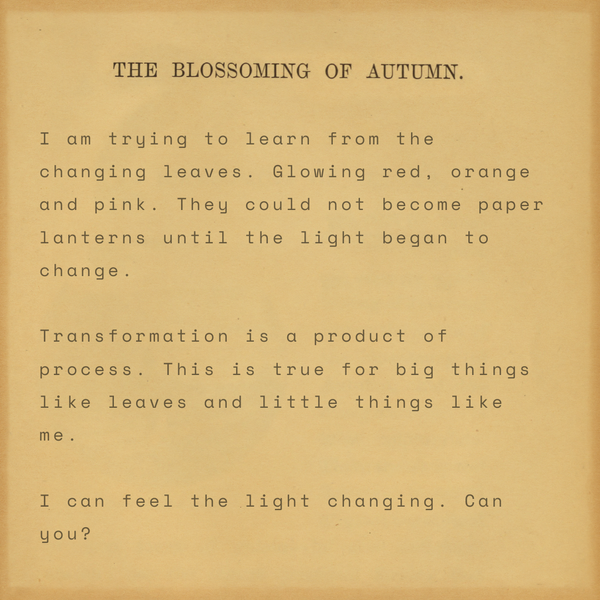In Sepsis and in Health
My daughter, Dobbs and inflammatory systems

Margaret was sick for the first two weeks of June. It wasn’t Covid. My other two daughters got it, too, though not as bad. A reminder that Covid is novel, but illness is not. Margaret felt better on a Friday.
The following Monday, she went on a walk. It was hazy outside with wildfire smoke when she left the house. Within an hour, the smoke was thick enough to press through our window screens. I worried about her. She’s sensitive to bad air. She came in the front door while I was shutting the windows.
“Mom, I feel really bad.”
She had a headache, and her throat ached. I thought it was the smoke. We didn’t go to the doctor until Thursday. By then, her body hurt, too.
At the appointment, I told the pediatrician Margaret had a hard virus, gotten better for a few days, and then much worse. I thought she had a secondary bacterial infection. The pediatrician disagreed. I understand why she disagreed. Margaret’s vitals were normal; she could breathe easily, she didn’t have a fever, and her strep test was negative. Margaret said, “I just don’t feel right.” The pediatrician said it was just another bad virus. She’d been seeing this a lot. Kids coming in with one virus within days of getting over another.
A consequence of Covid quarantining. She told me to take Margaret home and give her lots of water. If Margaret still felt bad on Monday, she’d order blood tests. But, she said with a smile, she didn’t expect to hear from us again.
I took Margaret home. But I shouldn’t have. I know about bacterial infections. I know how they look and feel, even with no fever. I failed Margaret in ignoring my knowing. But “I have a feeling” is not taken that seriously in many professional settings.
I spent a year and a half in hospital rooms and halls as my dad was ravaged by leukemia. My family spent all that time watching for signs of bacterial infections. The nurses taught us what to look for how to tell early and often when bacteria bloomed inside him. In a healthy person like Margaret, seeing and treating an infection early with antibiotics is nearly always lifesaving. My dad was immunocompromised, so seeing the infections early only helped until it didn’t. He got bacterial pneumonia in the hospital.
The infection moved into his blood. When his body deployed its defenses against the blood infection, it did too much. He developed sepsis, an inflammatory immune response that kills tissue, damages organs, and causes death. His heart rate and lactic acid climbed, and his blood pressure dropped. He went into septic shock.
Septic shock is the final stage of sepsis. It has a 40% mortality rate across all groups. That rate is much higher if you control for pre-existing conditions. Oxygen couldn’t get to his organs. His cells shrunk and died while we asked what more could be done. Nothing. His heart beat faster and faster while we held his hands, his arms, his legs. And then his heart stopped. Margaret was six years old when he died.
On Friday night, Margaret was still sick. Early Saturday morning, she came into our room crying. “Mom and Dad, I am so sick.” She stumbled into the bathroom; Riley followed and held her hair back while she vomited. We rushed her to the emergency room. She’s my size now, but I wanted to carry her into the hospital. Instead, she let me hold her hand. I think that’s when I knew how sick she was. They admitted her immediately.
The rooms in the ER are little bolt-holes with cords and monitors. There were no windows. That was somehow comforting. This wasn’t a place we were supposed to be for long. We kept our door ajar - look! The hall is right there. We can walk out of this room at any time. When the nurse put the heart monitor on Margaret’s finger, the number on the screen flashed over and over again. It said her heart rate was 150. I asked the nurse if she needed to adjust the monitor’s placement. That number seemed too high. “Nope! It’s on just the way it should be.” The nurse looked professionally unworried, which I know means very worried.
I watched Margaret’s heartbeat translate into numbers on the screen above her head: 150…152…160. The nurses put an IV into her arm while I held her head against my stomach. The nurse filled six vials with blood. Margaret’s not little anymore. She isn’t always falling down and scraping her knee. It’d been a long time since I’d seen her blood. It’s so red.
When we went to get her x-ray, she let me hold her hand again. Down the hall, past other windowless rooms. Many of the doors were propped open. They’d be walking out any minute, too. I kept my eyes ahead of me. But my brain registered a collection of points from each room—the bent elbow of a mother with her head in her hands. A child’s foot, uncovered, at the end of the bed. A nurse’s chin angled up as she stared at a monitor. The points made a picture. Each room held a constellation.
When the nurse showed me the x-ray, it looked like there was a hurricane in Margaret’s right lung. Everything looks like extreme weather these days, I guess. Bacterial pneumonia. But that wasn’t all. The infection had moved into her blood. They thought she was in compensatory septic shock, but they weren’t sure. She had a white blood cell count of 24,000. Her lactic acid was climbing. Her heart rate would not come down. They pumped fluids and antibiotics into her arm. We waited.
Humans have been trying to diagnose and treat sepsis since Hippocrates. We are still not very good. There is no test to diagnose sepsis. One medical journal I read called sepsis “insidious” because it is so difficult to diagnose in its earliest, most treatable stage. If sepsis and the infection causing it are caught during onset, IV fluids, and antibiotics can stave off septic shock. The first stage of sepsis can last a few hours or a few days.
One doctor we talked to thought Margaret was already septic by the time we took her to her pediatrician’s office on Thursday. Another thought it was more likely sepsis started on Friday. It’s hard to say.
Both agreed she’d progressed to septic shock by the time we got to the hospital Saturday morning. Both said things would have been much worse if we’d gotten her to the hospital even a few hours later. If she hadn’t thrown up, we would have gotten to the hospital much later. I can’t even consider that alternate reality.
The treatment for septic shock is the same as the treatment for sepsis; it’s just much less effective at that stage—lots of fluids and antibiotics. Severe cases require surgery to cut out infection and interventions to shore up struggling organ systems. People who survive septic shock often lose limbs, organs, and cognitive function. The number of people developing sepsis is rising worldwide, including in America.
Margaret’s blood pressure dipped but then returned to safe levels. Her lactic acid fell as treatment progressed. But her heart rate stayed above 150. She had to be admitted to the hospital. A nurse took us to the new room. He pushed Margaret’s wheelchair and told me where to find the chapel and the family respite room. We went up nine floors and walked past a dozen closed doors to get to her room. It had a big window.
I made my bed that night after she fell asleep. All hospital sheets are the same kind of rough. I was glad for it. I was too raw for softness. The next morning, she ate breakfast. Her heart rate fell below 120. She saw the number first, “Mom! My heart!” By that evening, it was low enough for her to go home. She was unlucky. And then she was lucky.
Will she stay lucky?
Margaret’s odds of future survival changed for the worse twice last week. The first change happened when her body responded to infection with systemic inflammation. Sepsis is a deadly new trick her body may not forget. People who develop sepsis and go into septic shock are more likely to go into septic shock again. The second change happened when Roe was overturned. The Dobbs decision is an inflammatory systemic reaction that puts Margaret and anyone who can get pregnant at greater risk of poor outcomes.
The rate of sepsis is increasing in pregnant people, as well as the general population. The World Health Organization reports that sepsis is one of the four leading causes of pregnancy-related mortality. Black women, people who are pregnant for the first time, people with diabetes, and people having miscarriages are at greater risk for developing sepsis while pregnant. Illegal and unsafe abortions lead to infection and sepsis at horrifying rates.
I saw the documentary "The Janes" recently. It's about a Chicago underground of women who provided access to abortions before Roe. Very solid.
— Eileen Clancy (@clancynewyork) June 24, 2022
Most striking to me – I learned Chicago had an entire "Septic Abortion" hospital ward. One woman per day died. https://t.co/zhEtwaigOS
Sepsis is even more challenging to diagnose in pregnant people. The onset of sepsis looks like pregnancy symptoms - higher heart rate, shortness of breath, and a general feeling of discomfort. Because it is harder to diagnose, sepsis in pregnant people can progress to later stages before being treated. Once diagnosed, it is harder to treat. Pregnant women metabolize antibiotics differently, so they are not as effective.
Medical journal articles about pregnancy and sepsis say that “induced birth is sometimes indicated” in treatment of a pregnant person with sepsis. Which is just a way to say, “Sometimes, the best hope of saving a septic pregnant person is getting the fetus out of their body so you can treat the infection and reaction more aggressively.” Induced birth before fetal viability is abortion.
Most anti-abortion trigger laws in effect after the end of Roe say abortion is legal when the life of the mother is at stake. But who decides when a person’s life is at stake? The PA didn’t recognize my daughter’s sepsis on Thursday. On Saturday, her father and I only knew something was wrong because she threw up. The nurses in the ER moved quickly, but it took time to gather all the information they needed to make a diagnosis.
We didn’t know for sure it was compensatory septic shock until Sunday morning. We knew then because the treatments worked, and a collection of specialists had time to discuss her case. Sometimes, like with Margaret, septic shock can be effectively treated without major interventions. But sometimes, it can’t. Who is going to decide a mother needs a life-saving abortion if the life-saving can’t be proven until after the abortion?
Do you know who knew something was gravely wrong? Margaret. On Thursday, she said, “I just don’t feel right.” On Friday, she said, “It’s like everything hurts everywhere, but it’s like an uncomfortable hurt, not a makes me cry hurt.” On Saturday, when she burst into our room, she insisted on the wrongness, and her body insisted too. On Saturday, in the hospital, she told me she was scared because it didn’t seem like it was just pneumonia, but she didn’t know why she felt that way. On Wednesday, after she’d been home for days, she started crying. “I am just so grateful to be here.” She knew how bad it was, and she knows how bad it could have been. She’s the one who knows. And so she is the one who gets to decide. Her. In sepsis and in health.
It’s been a week since we left the hospital. She’s done with her antibiotics. She’s still tired. We don’t know how long that will last. Her doctor said, “She’ll feel more fatigued for a couple weeks to a year. Sepsis affects everyone differently.”
I wish I could rearrange my matter and walk through the corridors of her body, just to be sure. The way I check our home before we leave for a long trip. Are the windows closed, the doors locked, the sinks turned off, the beds made? I’d count her white blood cells, put my cheek against her heart, and look between alveoli. Instead, when I wake up in the morning, I call down to her from upstairs, “Zuzu, how are you feeling?” I sit by her on the couch and try to read the color of her cheeks. I wash her sheets and make her favorite dinner.
After the kids go to bed, I listen for Margaret’s steady breathing. I turn off the lamp next to Viola’s bed. I lift Brontë’s blankets from the foot of her bed and over her chest. Care work is the anticipation of grief, theirs or mine. We care because we cannot keep or be kept. I know that.
And still, I stand in the hall for a minute before going to bed, too, and gasp,
Oh my God, my God. (You are my God. Am I yours?) Let me keep them. Let me keep them. Let us keep each other. What could it hurt?




